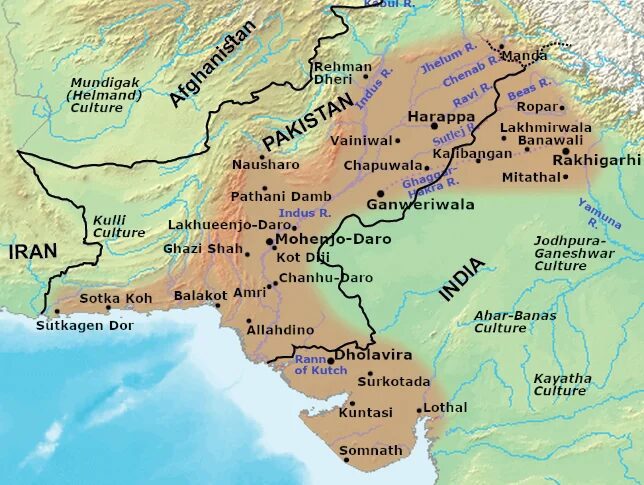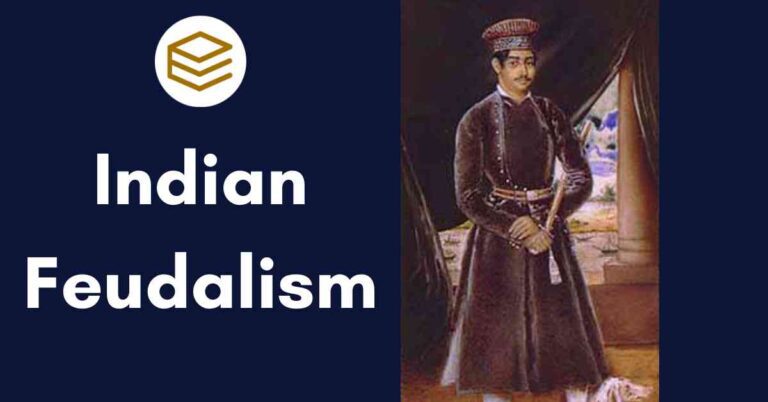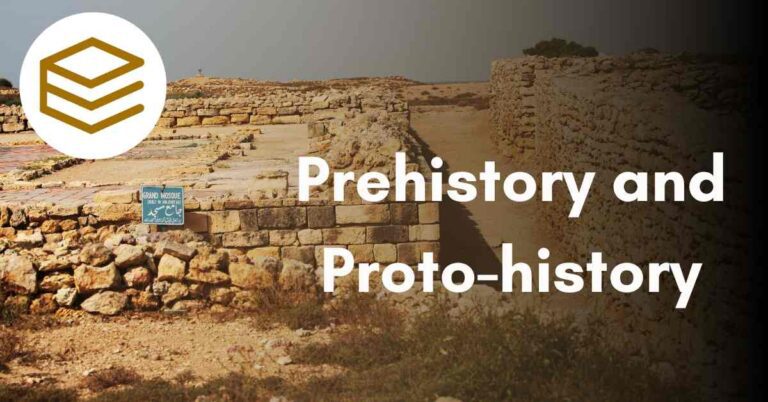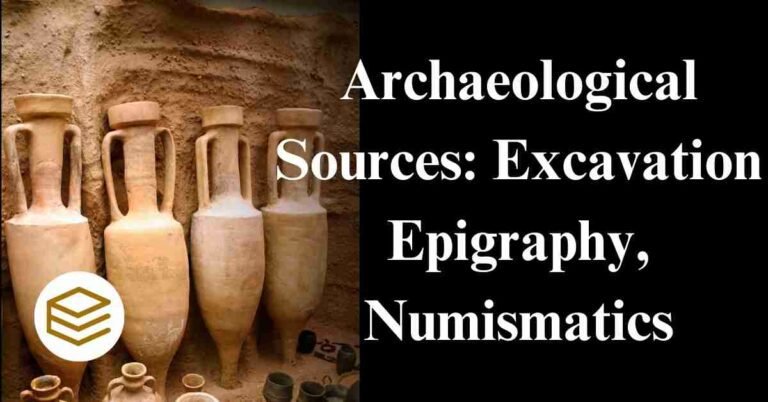December 8, 2025 5:28 pm
1.1 Why it is Called Harappan Civilization
The Harappan Civilization is named after Harappa, the first site discovered that revealed the existence of this ancient culture. Initially referred to as the Indus Valley Civilization due to the discovery of most settlements in the Indus River plains, scholars prefer the term Harappan Civilization following the convention of naming ancient cultures after the first significant archaeological site uncovered.
The Harappan Civilization extended beyond the Indus Valley, covering a vast area, including:
- Afghanistan
- Pakistan (Punjab, Sindh, Baluchistan, North-West Frontier Province)
- India (Jammu, Punjab, Haryana, Rajasthan, Gujarat, Western Uttar Pradesh)
Some notable boundary sites:
- West: Sutkagen-dor on the Makran coast (Pakistan)
- East: Alamgirpur in Uttar Pradesh (India)
- North: Shortughai in Afghanistan
Given this widespread reach, the term “Indus Valley” is somewhat limiting. Some scholars prefer “Indus–Sarasvati Civilization” due to many sites found along the Ghaggar-Hakra river, identified with the Rig Vedic Sarasvati river. However, Harappan Civilization remains the most widely accepted term.
1.2 Chronology: Pre-Harappan and Harappan Phases
The Harappan Civilization evolved through three distinct phases, each marking a stage in cultural and urban development:
| Period | Timeframe | Characteristics |
|---|---|---|
| Neolithic | 5500 BCE – 3200 BCE | Early settlements at Mehrgarh and Kili Ghul Muhammad in Baluchistan and Indus plains. Pastoralism, limited cultivation, permanent villages, and early knowledge of wheat, barley, dates, cotton, and domesticated animals such as sheep, goat, and cattle. |
| Early Harappan | 3200 BCE – 2600 BCE | Proto-urban phase. Use of copper, wheel, plough. Domestication of crops such as peas, sesame, cotton, and animals like water buffalo. Uniformities in pottery traditions begin to emerge. Trade networks developed with sources of raw materials (e.g., lapis lazuli). Key sites: Rehman Dheri, Amri, Kot Diji, Kalibangan. |
| Mature Harappan | 2600 BCE – 1900 BCE | The peak urban phase. Cities like Harappa, Mohenjodaro, Dholavira, and Kalibangan flourish with advanced town planning, uniform bricks, weights, and seals. Long-distance trade established with Mesopotamia. |
| Late Harappan | 1900 BCE – 1300 BCE | Decline of urban centers. Many cities were abandoned, though some continued regional traditions. The writing system declined, but pottery and crafts persisted. The village cultures in the Sutlej-Jamuna divide, Punjab, and Gujarat continued to practice Harappan traditions. |
1.3 Geographical Extent and Features
The Indus Valley Civilization encompassed a vast area across modern Pakistan, northwestern India, Afghanistan, and Iran. Its boundaries extended from Balochistan in the west to Uttar Pradesh in the east, from northeastern Afghanistan to Maharashtra in the south.

1.3.1 Key Geographical Regions
- Lower Indus Basin: Mohenjodaro dominated this agriculturally rich area of Sind, with lakes like Manchhar supporting fishing settlements.
- Upper Sind and Balochistan: Known for flint quarries and Harappan settlements with key trade routes linking to Baluchistan.
- Punjab (Pakistan and India): Home to Harappa and other significant sites in doabs (land between two rivers).
- Cholistan Desert: The Hakra River once flowed through this region, supporting the largest cluster of Harappan settlements, many with industrial activity.
- Ghaggar-Hakra Beds: Sites like Rakhigarhi (Haryana), Kalibangan, and Banawali are located along this river system.
- Rann of Kutch, Gulf of Cambay, and Kathiawad (Saurashtra): Dholavira and Lothal were important coastal settlements facilitating maritime trade.
1.4 Characteristics of the Harappan Civilization
1.4.1 Town Planning and Architecture
Harappan cities exhibited advanced town planning, featuring:
- Grid Pattern Layout: Cities were divided into two sections, the Citadel and the Lower Town. The citadel housed administrative and religious buildings, while the lower town contained residential and commercial areas.
- Brick Construction: Uniform baked bricks were used for buildings. Dholavira is known for its stone constructions.
- Drainage System: An impressive system of covered drains and soak pits managed wastewater effectively, reflecting an advanced understanding of urban sanitation.
Great Bath of Mohenjodaro: A large public bathing structure, possibly used for ritual purposes.
1.4.2 Subsistence Patterns
1.4.2.1 Agriculture
Agriculture was the backbone of the Harappan economy, with key crops including:
- Wheat, Barley, Rice, and Millets: These formed the staple diet across different regions.
- Cotton: Evidence of cotton cultivation has been found at Mohenjodaro.
- Seasonal Crops: The Harappans grew kharif (summer) and rabi (winter) crops, similar to modern-day agricultural practices.
1.4.2.2 Animal Husbandry
Domesticated animals like cattle, buffalo, sheep, and goats provided meat, milk, and labor. Hunting supplemented the diet with wild animals such as deer, boar, and fish.
1.5 Trade and Commerce
Harappans engaged in long-distance trade, evidenced by the discovery of Mesopotamian seals at Harappan sites. Trade items included:
- Metals: Copper and bronze tools and ornaments.
- Semi-Precious Stones: Lapis lazuli, carnelian, and turquoise.
- Seals and Beads: Used for administrative purposes and trade.
1.6 Decline of the Civilization
The decline of the Harappan Civilization began around 1900 BCE, with cities like Mohenjodaro showing signs of urban decay. The reasons for this decline include:
- Climate Change: River drying and changing monsoon patterns may have impacted agriculture.
- Shifts in Trade Routes: Changes in long-distance trade networks could have weakened the economy.
- Natural Disasters: Floods and tectonic activity could have led to the abandonment of cities.
By 1300 BCE, most urban centers had been abandoned, and the civilization shifted towards a rural-based economy.
1.7 Important Excavations and Sites
- Harappa: First excavated in 1921 by Dayaram Sahni, Harappa is located on the Ravi River in Punjab. It provided crucial insights into the civilization’s urban planning and social organization.
- Mohenjodaro: Excavated in 1922 by R.D. Banerjee, this site in Sindh revealed extensive town planning, the Great Bath, and advanced drainage systems.
- Kalibangan: Located on the Ghaggar River, it shows both pre-Harappan and Harappan phases. Excavations revealed fire altars and evidence of a furrowed field.
- Lothal: Discovered in Gujarat near the Gulf of Cambay, this site had a dockyard, indicating maritime trade.
- Dholavira: Excavated in Gujarat, known for its advanced water management systems and stone architecture.
key features of Harappan civilization sites:
| Site | Year of Excavation | Excavator | Region | Key Features |
|---|---|---|---|---|
| Harappa | 1921 | Daya Ram Sahni | Punjab, Pakistan | Grid planning, granaries, coffin burials, bead-making workshops, seals |
| Mohenjodaro | 1922 | R.D. Banerjee | Sindh, Pakistan | Great Bath, advanced drainage, multi-room houses, citadel, bronze figurines |
| Kalibangan | 1953 | A. Ghosh | Rajasthan, India | Fire altars, furrowed land, mud-brick platforms, evidence of earthquake |
| Lothal | 1953 | S.R. Rao | Gujarat, India | Dockyard, ship designs on seals, bead industry, rice cultivation |
| Dholavira | 1985-1990 | R.S. Bisht | Gujarat, India | Water reservoirs, unique town planning, inscriptions, stepped wells |
| Rakhigarhi | 1997 | Amarendra Nath | Haryana, India | Largest Harappan site, jewelry, animal figurines, evidence of writing |
| Banawali | 1974 | R.S. Bisht | Haryana, India | Fortified settlement, circular fire pits, barley remains, bangles |
| Chanhudaro | 1931 | N.G. Majumdar | Sindh, Pakistan | Bead factories, terracotta models, absence of citadel, seal-making |
| Surkotada | 1964 | J.P. Joshi | Gujarat, India | Evidence of horse bones, fortifications, mud-brick houses |
| Kot Diji | 1955 | Fazal Ahmed Khan | Sindh, Pakistan | Pre-Harappan layers, defensive walls, black-on-red pottery |
| Rangpur | 1931 | M.S. Vats | Gujarat, India | Rice cultivation, terracotta toys, copper tools |
| Balakot | 1973 | G.F. Dales | Sindh, Pakistan | Shell industry, early Harappan artifacts, fish remains |
| Allahdino | 1958 | George Dales | Sindh, Pakistan | Gold and silver ornaments, evidence of rural settlements |
| Sutkagan Dor | 1927 | Stein | Baluchistan, Pakistan | Trade route to Mesopotamia, mud-brick fortifications |
| Kunal | 1986 | S.R. Rao | Haryana, India | Pre-Harappan culture, gold jewelry, storage jars |
| Desalpur | 1963 | J.P. Joshi | Gujarat, India | Fortified site, stone walls, microlithic tools |
| Amri | 1929 | N.G. Majumdar | Sindh, Pakistan | Early Harappan phase, pottery, terracotta figurines |
| Nageshwar | 1983 | M.H. Raval | Gujarat, India | Shell-working industry, evidence of coastal trade |
| Bhagatrav | 1950 | S.R. Rao | Gujarat, India | Port town, semi-precious stones, trade links with Mesopotamia |
| Kanmer | 2005 | J.S. Kharakwal | Gujarat, India | Fortification, pottery, shell artifacts, water management |
| Shortugai | 1976 | Viktor Sarianidi | Afghanistan | Lapis lazuli trade, evidence of canal irrigation |
| Daimabad | 1958 | B.K. Thapar | Maharashtra, India | Bronze chariot, pottery, terracotta figurines |
| Ganweriwala | 1975 | Rafique Mughal | Punjab, Pakistan | Fifth largest Harappan site, no major excavations yet |
| Khanak | 2006 | Archaeological Survey | Haryana, India | Mining site, semi-precious stone beads |
| Sanauli | 2005 | Amarendra Nath | Uttar Pradesh, India | Copper coffin burials, chariots, warrior artifacts |
| Rojdi | 1955 | Archaeological Survey | Gujarat, India | Agriculture-based settlement, black-on-red pottery |
| Hulas | 1978 | B.B. Lal | Uttar Pradesh, India | Mud-brick structures, hearths, storage pits |
| Bagasra | 1996 | S. Pratap | Gujarat, India | Industrial center, semi-precious stone beads, faience objects |
| Mitathal | 1968 | Suraj Bhan | Haryana, India | Double defensive walls, early Harappan pottery |
Ancient History
- Harappan Civilization Date, Extent, and Characteristics
- Paleolithic Age in India
- Mesolithic Rock Paintings in India
- Neolithic Age in India
- Vedic Age in India
- The Significance of Megalithic Burials in India: Unearthing the Iron Age Heritage
- Expansion of Aryans in India: Migration, Settlement, and Cultural Evolution
- Formation of States (Mahajanapadas): Republics and Monarchies
- Jainism : An Overview of Ancient Indian Religions
- Buddhism – An Overview of Ancient Indian Religions
- Chandragupta Maurya
- Iranian and Macedonian Invasions of India and Their Impact
- Mauryan Art, Architecture, and Sculpture
- Megasthenes’ Indika
- Mauryan Empire: Foundation and Expansion
- Chanakya’s Arthashastra: A Book on Ancient Indian Statecraft
- Archaeological Sources: Excavation Epigraphy, Numismatics
- Prehistory and Proto-history : A detailed Analysis







[…] Harappan Civilization Date, Extent, and Characteristics : An Unsolved Mystery of 4th Millenia BC (PD… […]
[…] Harappan Civilization Date, Extent, and Characteristics : An Unsolved Mystery of 4th Millenia BC (PD… […]
[…] Harappan Civilization Date, Extent, and Characteristics : An Unsolved Mystery of 4th Millenia BC (PD… […]
[…] Harappan Civilization Date, Extent, and Characteristics : An Unsolved Mystery of 4th Millenia BC (PD… […]
[…] Harappan Civilization Date, Extent, and Characteristics : An Unsolved Mystery of 4th Millenia BC (PD… […]
[…] Harappan Civilization Date, Extent, and Characteristics : An Unsolved Mystery of 4th Millenia BC (PD… […]
[…] Harappan Civilization Date, Extent, and Characteristics : An Unsolved Mystery of 4th Millenia BC (PD… […]
There’s a rare magic in your ability to speak to both the intellect and the heart, leaving the reader with a profound sense of connection.
Each paragraph flows like a river, guiding the reader through a landscape of ideas with ease and clarity.